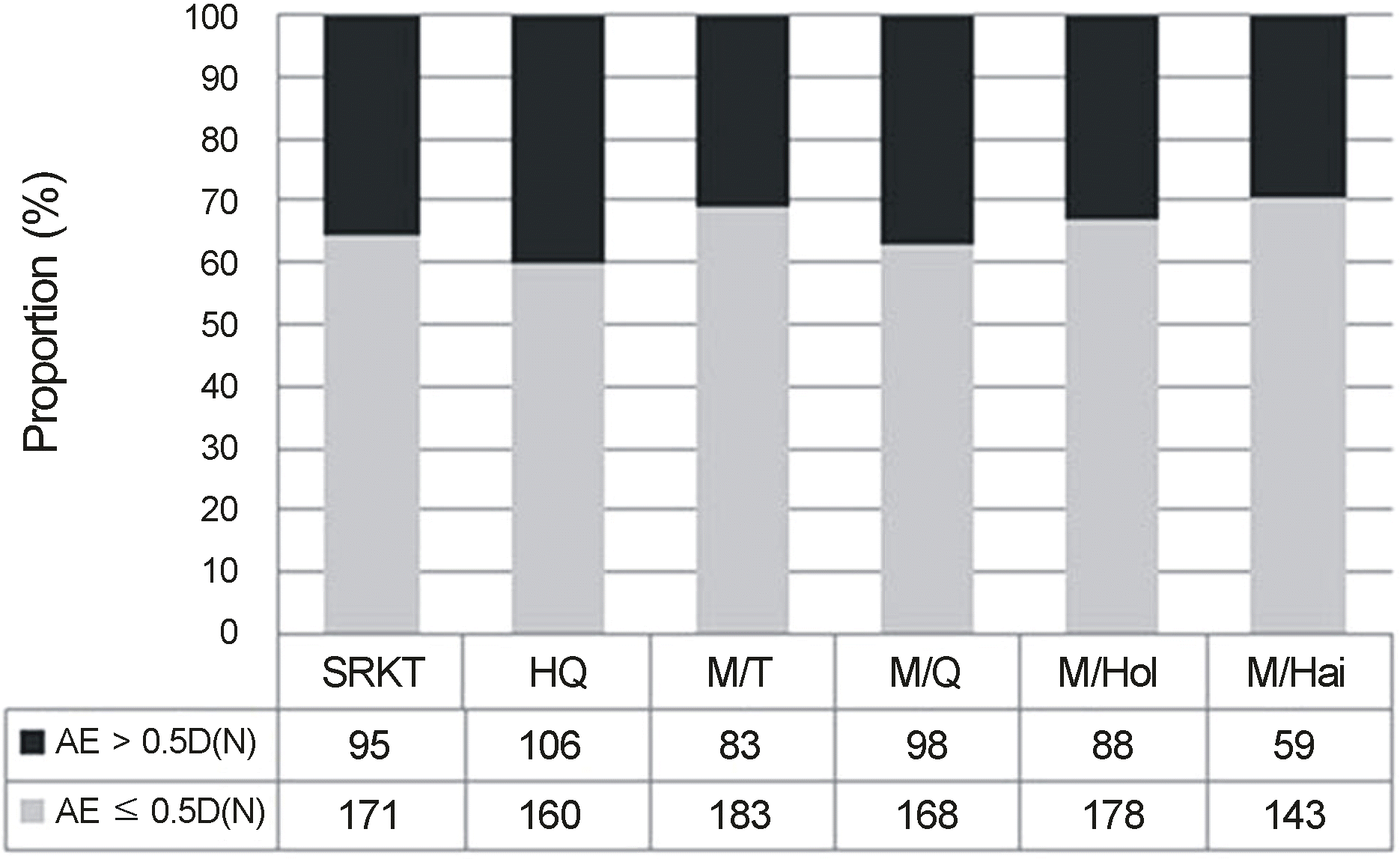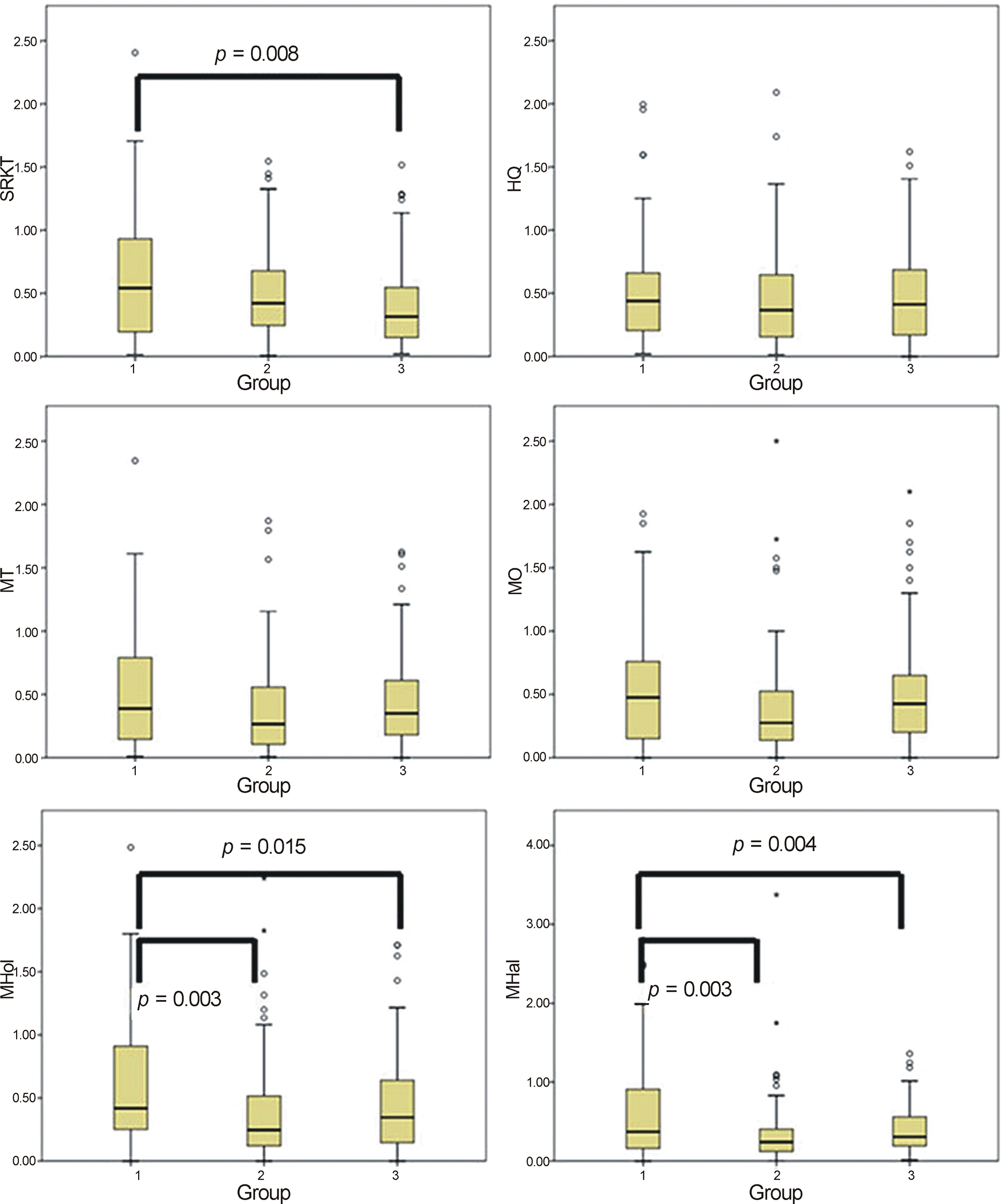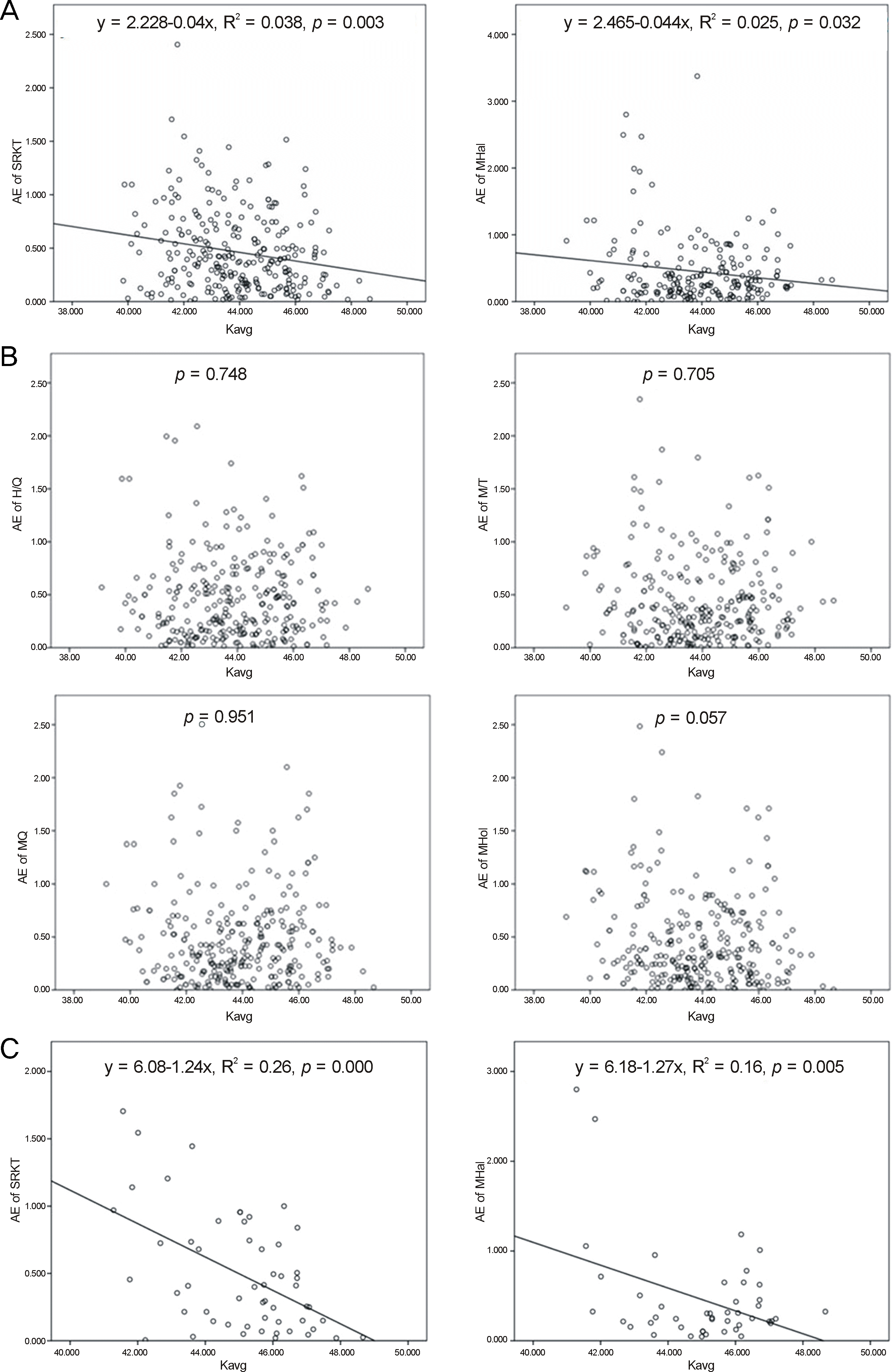Abstract
Purpose
To investigate which factors primarily influence refractory errors between various formulas used to calculate intraocular lens (IOL) power.
Methods
Records of 266 eyes of 191 patients who underwent uneventful cataract surgery were reviewed retrospectively. IOL power was determined using SRK/T, HofferQ (H/Q), Master SRK/T (M/T), Master HofferQ (M/Q), Master Holladay (M/Hol), and Master Haigis (M/Hai). The mean absolute error (MAE) of each formula was compared; MAE was defined as the difference between the postoperative spherical equivalence (SE) determined 1 month after surgery and the predicted SE. Factors that could have influenced interformula refractive errors were analyzed. Patients were divided into 3 groups based on average keratometric value (Kavg) and the inter-group differences of the AE of each formula were analyzed. Effects of corneal curvature on changes in AE of each formula were evaluated by linear regression.
Results
The MAE was minimized in the M/T formula, followed by the M/Hol, M/Hai, SRK/T, H/Q, and M/Q formulas. Interformula MAE differences were not statistically significant. Kavg and AXL were significantly influenced by the different predictive values between formulas in univariate analysis, but only AXL was significant in multivariate analysis. The AE in each formula among the 3 groups according to keratometry was significantly different in SRK, M/Hol, and M/Hai. Linear regression analysis showed a significant negative correlation between Kavg, AE of SRK/T and the MHai formula. In partic-ular, this effect was more pronounced in those with short AXL (<22.5 mm).
Go to : 
References
1. Holladay JT.Refractive power calculations for intraocular lenses in the phakic eye. Am J Ophthalmol. 1993; 116:63–6.

2. Drexler W, Findl O, Menapace R. . Partial coherence inter-ferometry: a novel approach to biometry in cataract surgery. Am J Ophthalmol. 1998; 126:524–34.

3. Eleftheriadis H.IOLMaster biometry: refractive results of 100 consecutive cases. Br J Ophthalmol. 2003; 87:960–3.

4. Holladay JT, Prager TC, Ruiz RS. . Improving the predict-ability of intraocular lens power calculations. Arch Ophthalmol. 1986; 104:539–41.

5. Lee AC, Qazi MA, Pepose JS.Biometry and intraocular lens power calculation. Curr Opin Ophthalmol. 2008; 19:13–7.

6. MacLaren RE, Natkunarajah M, Riaz Y. . Biometry and for-mula accuracy with intraocular lenses used for cataract surgery in extreme hyperopia. Am J Ophthalmol. 2007; 143:920–31.

7. Gavin EA, Hammond CJ.Intraocular lens power calculation in short eyes. Eye (Lond). 2008; 22:935–8.

8. Terzi E, Wang L, Kohnen T.Accuracy of modern intraocular lens power calculation formulas in refractive lens exchange for high myopia and high hyperopia. J Cataract Refract Surg. 2009; 35:1181–9.

9. Wang L, Shirayama M, Ma XJ. . Optimizing intraocular lens power calculations in eyes with axial lengths above 25.0 mm. J Cataract Refract Surg. 2011; 37:2018–27.

10. Roh YR, Lee SM, Han YK. . Intraocular lens power calculation using IOLMaster and various formulas in short eyes. Korean J Ophthalmol. 2011; 25:151–5.

11. Haigis W.The Haigis formula. HJ S, editor. Intraocular lenspower calculations. Thorofare, NJ: Slack;2004. chap. 5.
12. Olsen T, Olesen H, Thim K, Corydon L.Prediction of post-operative intraocular lens chamber depth. J Cataract Refract Surg. 1990; 16:587–90.

13. Olsen T.The Olsen formula. HJ S, editor. Intraocular Lens Power Calculations. Thorofare, NJ: Slack;2004. chap. 4.
14. Olsen T, Thim K, Corydon L.Theoretical versus SRK I and SRK II calculation of intraocular lens power. J Cataract Refract Surg. 1990; 16:217–25.

15. Hoffer KJ.The Hoffer Q formula: a comparison of theoretic and re-gression formulas. J Cataract Refract Surg. 1993; 19:700–12.

16. Holladay JT, Prager TC, Chandler TY. . A three-part system for refining intraocular lens power calculations. J Cataract Refract Surg. 1988; 14:17–24.

17. Holladay JT, Prager TC.Accurate ultrasonic biometry in pseudophakia. Am J Ophthalmol. 1989; 107:189–90.

18. Retzlaff JA, Sanders DR, Kraff MC.Development of the SRK/T intraocular lens implant power calculation formula. J Cataract Refract Surg. 1990; 16:333–40.

19. Holladay JT.Standardizing constants for ultrasonic biometry, kera-tometry, and intraocular lens power calculations. J Cataract Refract Surg. 1997; 23:1356–70.

20. Findl O, Kriechbaum K, Sacu S. . Influence of operator experi-ence on the performance of ultrasound biometry compared to opti-cal biometry before cataract surgery. J Cataract Refract Surg. 2003; 29:1950–5.

21. Lee YE, Choi KR, Jun RM.Accuracy of intraocular lens power calculations according to the formulas and anterior chamber depth in short eyes. J Korean Ophthalmol Soc. 2010; 51:1338–44.

22. Donoso R, Mura JJ, López M, Papic A.[Emmetropization at cata-ract surgery. Looking for the best IOL power calculation formula according to the eye length]. Arch Soc Esp Oftalmol. 2003; 78:477–80.
Go to : 
 | Figure 1.The proportion of eyes with an absolute error (AE) of less than 0.5 diopter and more than 0.5 diopter. The proportion of AE less than 0.5 D was greatest in the M/Hai formula (70.7%), followed by the M/T (68.7%), M/Hol (66.9%), SRK/T (64.2%), M/Q (63.1%), and H/Q (60.1) formulas. D = diopter; AE = absolute error; HofferQ = H/Q; Master SRK/T = M/T; Master HofferQ = M/Q; Master Holladay = M/Hol; Master Haigis = M/Hai. |
 | Figure 2.Comparison of mean absolute error in each formula between the 3 groups according to keratometry values. Significant difference of mean absolute error exists between group 1 and group 3 in SRK/T and between group 1 and group 2, group 1 and group 3 in M/Hol and M/Hai. Significance of the p is defined as less 0.05 by Turkey’s HSD test. HofferQ = H/Q; Master SRK/T = M/T; Master HofferQ = M/Q; Master Holladay = M/Hol; Master Haigis = M/Hai. |
 | Figure 3.Linear regression analysis. (A) Linear regression analysis shows a significant negative correlation between average K (x) and the AE of SRK/T and MHai formula (y). The best fit line has the equation y = 2.228 -0.04 x in SRK/T (R2 = 0.038, p = 0.003) and y = 2.465-0.044x (R2 = 0.025, p = 0.032). (B) Linear regression analysis shows an insignificant correlation between average K and the AE of H/Q (p = 0.748), M/T (p = 0.705), M/Q (p = 0.951), and M/Hol (p = 0.057) formulas. (C) Linear regression analysis shows a significant negative correlation between average K (x) and the AE of SRK/T formula (y) and M/Hai in the short axial length group. The best fit line has the equation y = 5.955-0.121x (R2 = 0.237, p = 0.000,) in SRK/T and y = 5.955-0.121x (R2 = 0.237, p = 0.000) in M/Hai. Kavg = average keratometric value; AE = absolute error; Master Haigis = M/Hai; HofferQ = H/Q; Master SRK/T = M/T; Master HofferQ = M/Q; Master Holladay = M/Hol. |
Table 1.
Information of four intraocular lens subtypes and number of uses
| SA60AT | AR40e | SN60WF | Tecnis ZCB00 | |
|---|---|---|---|---|
| Company | Alcon | AMO | Alcon | AMO |
| Optic type | Spheric | Spheric | Aspheric | Aspheric |
| A constant | 118.4 | 118.4 | 118.7 | 118.8 |
| Piece(s) | 1 | 3 | 1 | 1 |
| Eyes (numbers) | 77 | 14 | 155 | 20 |
Table 2.
Comparison of mean absolute errors (MAE) between formulas and number of eyes with mean absolute errors less than 0.5 diopter, more than 1 diopter, and more than 2 diopter
Table 3.
Characteristics of 3 groups classified on average keratometry values
| Group 1* | Group 2† | Group 3‡ | Total | Sig§ | |
|---|---|---|---|---|---|
| Eyes (number) | 46 | 95 | 125 | 266 | |
| Mean age (years) | 63.5 ± 18.0 | 67.4 ± 9.1 | 68.4 ± 10.3 | 67.23 ± 10.7 | p = 0.156 |
| Kavg (diopter) | 41.18 ± 0.69 | 43.10 ± 0.55 | 45.47 ± 0.97 | 43.86 ± 1.83 | p = 0.000 |
| AXL (mm) | 25.63 ± 2.40 | 24.91 ± 2.90 | 23.75 ± 2.58 | 24.50 ± 2.76 | p = 0.000 |
| ACD (mm) | 2.63 ± 0.45 | 2.54 ± 0.42 | 2.64 ± 0.48 | 2.61 ± 0.45 | p = 0.238 |
| MAE (diopter) | |||||
| SRKT | 0.59 ± 0.48 | 0.49 ± 0.35 | 0.39 ± 0.32 | 0.46 ± 0.37 | p = 0.018 |
| H/Q | 0.53 ± 0.48 | 0.45 ± 0.39 | 0.45 ± 0.35 | 0.46 ± 0.37 | p = 0.639 |
| M/T | 0.54 ± 0.50 | 0.38 ± 0.38 | 0.43 ± 0.35 | 0.43 ± 0.39 | p = 0.129 |
| M/Q | 0.56 ± 0.49 | 0.39 ± 0.40 | 0.49 ± 0.41 | 0.47 ± 0.43 | p = 0.081 |
| M/Hol | 0.61 ± 0.51 | 0.38 ± 0.39 | 0.42 ± 0.36 | 0.44 ± 0.41 | p = 0.009 |
| M/Hai | 0.69 ± 0.74 | 0.37 ± 0.49 | 0.39 ± 0.30 | 0.44 ± 0.49 | p = 0.006 |
Table 4.
Characteristics of 3 groups classified according to axial length values
| Group a* | Group b† | Group c‡ | Total | |
|---|---|---|---|---|
| Eyes (numbers) | 55 | 142 | 69 | 266 |
| Mean age (years) | 67.3 ± 12.3 | 70.3 ± 7.5 | 61.1 ± 13.4 | 67.23 ± 10.7 |
| AXL (mm) | 21.96 ± 0.40 | 23.7 ± 0.64 | 28.24 ± 2.84 | 24.50 ± 2.76 |
| Kavg (diopter) | 45.15 ± 1.72 | 43.7 ± 1.69 | 43.12 ± 1.69 | 43.86 ± 1.83 |
| ACD (mm) | 2.28 ± 0.33 | 2.57 ± 0.40 | 2.97 ± 0.36 | 2.61 ± 0.45 |




 PDF
PDF ePub
ePub Citation
Citation Print
Print


 XML Download
XML Download